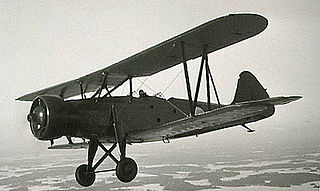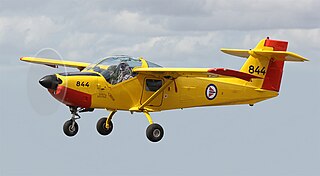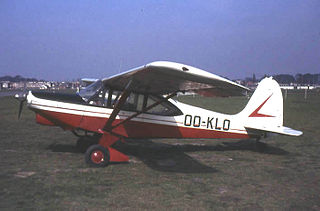
The Fokker S-11 Instructor is a single-engine two-seater propeller aircraft designed and manufactured by the Dutch aircraft manufacturer Fokker. It first flew in December 1947 and went on production, serving in several Air Forces in the late 20th century. The S-12 was a tricycle landing version of this aircraft.

The VL Tuisku was a Finnish trainer aircraft designed in the 1930s. It was a two-seat, single-engined biplane with a welded steel framework, covered with fabric. 30 were produced for the Finnish Air Force and served from 1935 to 1949.

Saab MFI-15 Safari, also known as the Saab MFI-17 Supporter, is a propeller-powered basic trainer aircraft used by several air forces.

The Nord Aviation 3202 was a 1950s French military trainer aircraft designed and built by Nord Aviation to meet a French Army requirement for a two-seat basic trainer, as a replacement for the biplane Stampe SV.4. Altogether, 101 examples were built, with the first flying on 17 April 1957.

The Aerotec A-122 Uirapuru was a Brazilian military trainer aircraft. It was a low-wing monoplane with tricycle undercarriage that accommodated the pilot and instructor side-by-side. It first flew on 2 June 1965.

The LWD Żak was a Polish touring and trainer aircraft of the late 1940s, designed in the LWD and built in a short series.

The Aubert PA-20 Cigale, PA-204 Cigale Major and PA-205 Super Cigale were a family of high-wing cabin monoplanes built in France in the years immediately before and immediately after World War II. The original Cigale was shown at the 1938 Paris Salon but its development was interrupted by the War. The Cigale was a high wing cantilever monoplane of conventional configuration with fixed, tailwheel undercarriage.

The Boisavia B.60 Mercurey was a series of four-seat light aircraft developed in France shortly after World War II.

The Klemm Kl 107 was a two-seat light aircraft developed in Germany in 1940. It was a conventional low-wing cantilever monoplane of wooden construction with fixed tailwheel undercarriage. Wartime production totalled only five prototypes and some 20 production machines before the Klemm factory was destroyed by Allied bombing. Following World War II and the lifting of aviation restrictions on Germany, production recommenced in 1955 with a modernised version, the Kl 107B, of which Klemm built a small series before selling all rights to the design to Bölkow. This firm further revised the design and built it as the Kl 107C before using it as the basis for their own Bo 207.

The Fokker F.25 Promotor, first flown in 1946, was a single-engined, twin-boomed, four-seat passenger monoplane with a pusher engine mounted at the rear of a central nacelle. It was of wooden construction and has fitted with a retractable nosewheel undercarriage. One feature of the design was that instead of a 2 + 2 seating, the pilot sat in front to the left, and all three passengers were on a bench seat to the rear of him. Alternatively, when being used as an air ambulance aircraft, it could carry a patient on a stretcher, which was loaded through a hatch in the aircraft's nose. The F.25 was evocative of the pre-war G.I design.

The CAP-4 Paulistinha was a military and civilian trainer aircraft built in Brazil during the 1930s and 1940s.

The DINFIA IA 35 Huanquero was a 1950s Argentine twin-engined general-purpose monoplane aircraft built by the DINFIA.

The Fiat G.46 was a military trainer developed in Italy shortly after World War II.

The Fiat G.80 was a military jet trainer designed and produced by the Italian aircraft manufacturer Fiat. It has the distinction of being the first true jet-powered indigenous aircraft to be flown by Italy.
The Hispano HS-42 and its derivative, the HA-43, were advanced military trainer aircraft produced in Spain in the 1940s. The basic design was that of a conventional, low-wing, cantilever monoplane with seating for the pilot and instructor in tandem. The HS-42 had fixed, tailwheel undercarriage with spatted mainwheels, while the HA-43 had retractable main units. Produced on the assembly line that had been used to build Fokker D.XXI fighters, the HS-42 shared some components with this aircraft.
The Casmuniz 52 was a twin-engine light transport aircraft. It was the first all-metal aircraft built in Brazil, only the prototype was built.

The Macchi MB.320 was an Italian cabin monoplane designed and built by Macchi. Only a small number were built.
The Temco 58 was a low wing single engine, tandem seat propeller driven trainer designed for sale to overseas air forces. It did not reach production.
The de Bernardi M.d.B. 02 Aeroscooter is a two-seat light sport aircraft designed by Mario De Bernardi as a follow-on to the single-seat Partenavia P.53 Aeroscooter.

The Dittmar HD 153 Motor-Möwe was a West German light aircraft that was first flown in November 1953.


















